
Contents
The usage of the particle "の-no"
The particle 「の」 is one of the most versatile particles in Japanese, typically used to connect two nouns and show relationships between them. It can indicate possession, affiliation, or provide additional context. Below are three primary uses of 「の」.
- Showing Affiliation or Belonging
- Explaining the Subject or Theme
- Indicating Possession or Ownership
1. Showing Affiliation or Belonging
In this usage, 「の」 indicates that Noun1 is an organization, group, or category to which Noun2 belongs. It is commonly used to show a relationship, such as one’s school, workplace, or field of study.
(1) わたしは 東京大学の 学生です。
I am a student at the University of Tokyo.
(2) かれは にほんごの 学生です。
He is a student of the Japanese language.
2. Explaining the Subject or Theme
In this usage, the particle 「の」 connects two nouns to describe what the second noun is about. It helps specify the topic or theme of the second noun. For example:
(1) これは コンピューターの ほんです。
This is a book on computer.
(2) それは にほんごの ほんですか。
Is it a book on Japanese?
3. Indicating Possession or Ownership
「の」 is also used to show ownership, similar to using “’s” in English. This is one of the most common uses of 「の」, as it specifies who something belongs to.
(1) これは わたしの かばんです。
This is my bag.
(2) これは あなたの ほんですか。
Is this your book?






